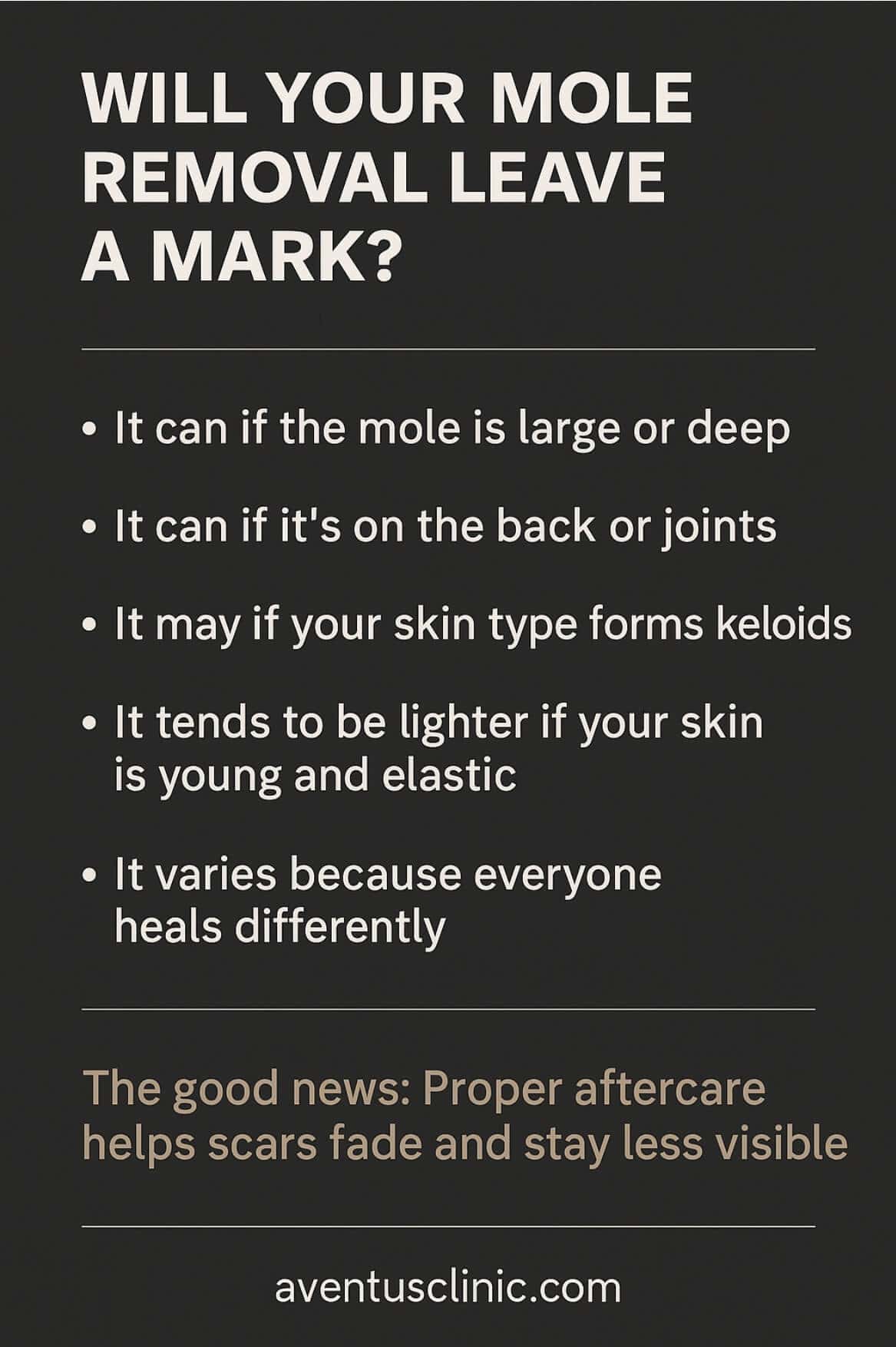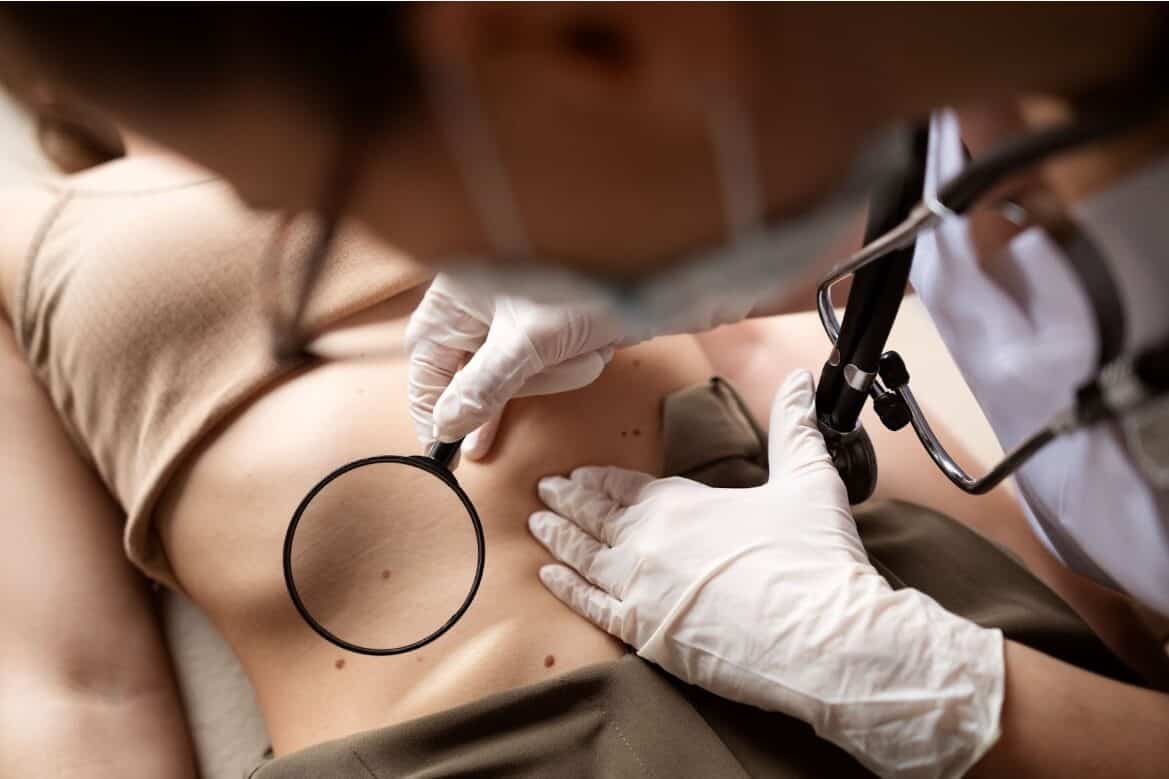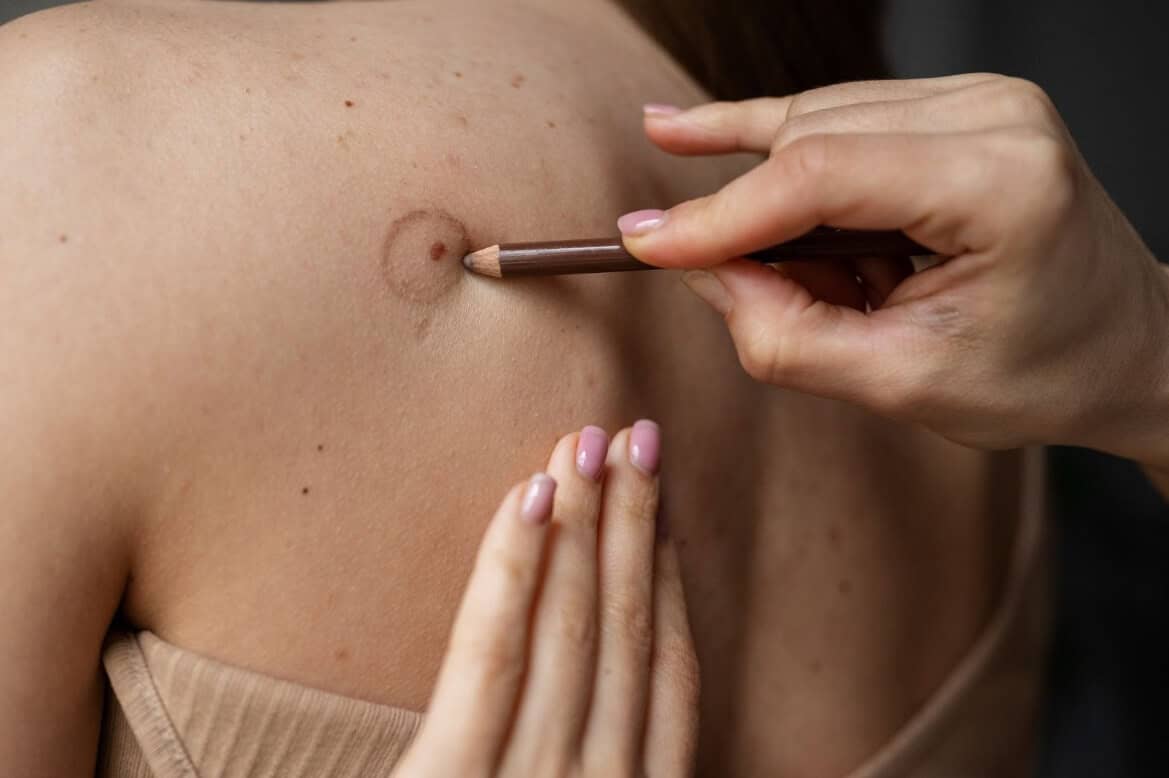Yes, mole removal typically leaves some scarring, but with proper technique and aftercare, most scars fade significantly. Location, removal method, and wound care all influence final appearance.
- Dr Sharon Crichlow
- Reading Time: 10 Mins
If you’re considering mole removal, you’re likely wondering about potential scarring. It’s a common concern that deserves a straightforward answer. While most mole removal procedures do leave some form of mark, modern techniques and proper aftercare can significantly minimise visible scarring.
When performed by skilled clinicians using advanced methods, mole removal typically results in minimal scarring that fades over time. Knowing the factors that influence healing can help you achieve the best possible cosmetic outcome.
Key Takeaways
- All mole removal methods leave some form of scarring, but visibility varies based on technique, location, and individual healing factors.
- Proper aftercare is crucial; silicone products, sun protection, and avoiding wound tension significantly reduce visible scarring.
- Modern removal techniques performed by skilled practitioners offer the best chance for minimal, less noticeable scarring outcomes.
Table of Contents
Does Mole Removal Leave a Scar?
Yes, mole removal typically leaves some form of scar, but the visibility varies significantly based on the removal method used.
A mole (naevus) consists of cells that extend through multiple layers of skin. When removed, it leaves a gap that must heal, inevitably creating some form of scar. The key question isn’t whether there will be a scar, but how noticeable it might be.
Different removal techniques produce different scarring outcomes:
Surgical excision involves cutting out the entire mole and stitching the skin closed. This method generally leaves a linear scar, which may fade over time but remains visible.
Shave excision removes the raised portion of a mole without cutting deeply into the skin. This technique typically leaves a flatter, less noticeable scar but may not be suitable for potentially cancerous moles requiring complete removal.
Laser removal uses focused light energy to break down mole tissue. It can be less invasive for certain types of moles. However, research shows it may still leave marks, particularly hypopigmentation (lighter skin patches).
Research by Bandral et al. (2018) compared laser, surgical, and electrosurgical methods for facial mole removal. Interestingly, after 90 days, all three techniques showed similar overall scar appearance, though laser and electrosurgical methods more frequently caused hypopigmentation (lighter patches).
| Removal Method | Scarring Outcome | Best For |
|---|---|---|
| Surgical Excision | Linear scar | Complete mole removal, suspicious moles |
| Shave Excision | Flat, circular scar | Raised, benign moles |
| Laser Removal | Minimal scarring | Surface moles, cosmetic concerns |
The choice of method depends on the mole’s size, location, and whether there are any cancer concerns.
What Factors Influence Healing and Scarring?
Several factors affect how your skin heals after mole removal and the resulting scar appearance.
Mole characteristics
The size, depth, and location of your mole significantly impact scarring potential. Larger, deeper moles naturally require more extensive removal, potentially leading to more noticeable scars. Moles in areas with high skin tension or movement, such as joints or the chest, tend to heal with more prominent scarring.
Patient factors
Your age, skin type, and genetic predisposition all play crucial roles in how you heal. Younger skin generally has better elasticity and healing capacity, while certain skin types are more prone to hyperpigmentation or keloid formation.
Recent studies suggest that even your gut microbiome may influence scar formation, highlighting how individual biology impacts healing processes.
Procedural factors
The skill and experience of your practitioner significantly affect scarring outcomes. A professional with extensive experience in mole removal will use techniques that minimise trauma and optimise healing.
Proper wound closure is vital. The technique used, whether simple stitches, layered closure, or allowing natural healing for smaller wounds, must be matched appropriately to the removal site and mole characteristics.

Tips to Reduce Scarring After Mole Removal
Taking proper care of your wound after mole removal is crucial for minimising scars. Here are evidence-based strategies to promote optimal healing:
Post-Procedure Wound Care
Keep the wound clean and covered for the first few days. Change dressings as recommended by your practitioner, typically once or twice daily.
Avoid using alcohol-based products on the wound as these can interfere with healing. Instead, use gentle, non-irritating cleansers if instructed by your provider.
Follow our comprehensive mole removal aftercare instructions to ensure optimal healing and minimal scarring.
Long-Term Scar Prevention
Sun protection is absolutely crucial. UV exposure can darken healing scars and make them more noticeable. Apply SPF 30+ sunscreen to the area once the wound has closed, and continue this practice for at least a year.
Avoid activities that stretch or put tension on the healing site. This mechanical stress can widen scars and disrupt the healing process.
Never pick at scabs that form during healing. This can lead to infection and significantly worsen scarring.
Evidence-Based Scar Treatments
Silicone-based products have strong scientific support for scar management. A 2024 study by J Cho et al. found that consistent use of silicone gel sheets or thin silicone gel significantly improved scar characteristics.
| Scar Treatment | Effectiveness | Best For | When to Start |
|---|---|---|---|
| Silicone Sheets/Gel | High | Raised scars, preventing hypertrophic scars | After wound closure (typically 2 weeks) |
| Scar Massage | Moderate | Improving scar flexibility, reducing tightness | Once healed (3–4 weeks) |
| Vitamin E | Limited evidence | Moisturising scar tissue | After wound closure |
| Compression | Moderate | Flattening raised scars | Once healed, under medical guidance |
Gentle massage of the healed scar can help improve blood flow and break up scar tissue. Begin only after the wound has completely closed, typically 3-4 weeks after removal.
Modern Techniques That Minimise Scarring
Advances in dermatological technology have dramatically improved scarring outcomes:
- Precision Instruments: Modern surgical tools allow for more precise incisions, reducing trauma to surrounding tissues. This precision contributes to cleaner healing and less noticeable scars. Our mole removal specialists in Hertfordshire utilise the latest techniques to ensure minimal scarring and optimal aesthetic outcomes.
- Advanced Suturing Techniques: Our specialists employ fine suturing methods that minimise tension and produce thinner, less visible scars. Face stitches can be removed early to prevent additional scarring.
- Laser Technology: According to a 2024 systematic review by Yenyuwadee et al., low-level laser therapy and pulsed dye laser show similar effectiveness in reducing surgical scar severity.
- Post-Procedure Interventions: For patients prone to problematic scarring, early intervention with corticosteroid injections or other treatments can prevent hypertrophic or keloid scars from developing.
The right technique depends on your specific situation, including the mole’s characteristics and your skin type. Before considering mole removal, we recommend scheduling a professional mole checking service to determine which approach would best suit your specific case.
Conclusion
If you’re concerned about a mole or have questions about removal options, taking action early is always best. Book your free online assessment today to discuss your specific concerns with our specialists and determine the most appropriate treatment approach for your needs.
FAQs
Which mole removal method leaves the least visible scar?
Laser removal typically leaves the least visible scarring, particularly for small, superficial moles. However, the best method depends on your specific mole characteristics and location. Shave excision also tends to leave minimal scarring for raised moles.
How long does it take for a mole removal scar to heal completely?
Initial healing occurs within 1-3 weeks, but complete scar maturation takes 6-12 months. During this period, the scar will gradually fade and flatten. The location of the mole and your individual healing characteristics affect this timeline.
Can mole removal scars fade over time?
Yes, most mole removal scars fade significantly over time. The scar will typically appear red or pink initially before gradually fading to a lighter shade than your natural skin tone. Complete fading varies by individual and can take several months to years.
What products help reduce scarring after mole removal?
Silicone-based products (sheets or gels) have the strongest evidence for scar reduction. Other helpful products include sun protection, moisturisers with ingredients like vitamin E, and medical-grade scar creams containing ingredients such as onion extract or centella asiatica.
When should I be concerned about my healing mole removal site?
Contact your clinician if you notice increasing redness, warmth, pain, swelling, pus, fever, or if the wound reopens. These could indicate infection. Also seek advice if your scar becomes raised, itchy, or increasingly red after initial healing, as this might suggest hypertrophic or keloid scarring.
 Free Online Assessment
Free Online Assessment WHATSAPP
WHATSAPP







